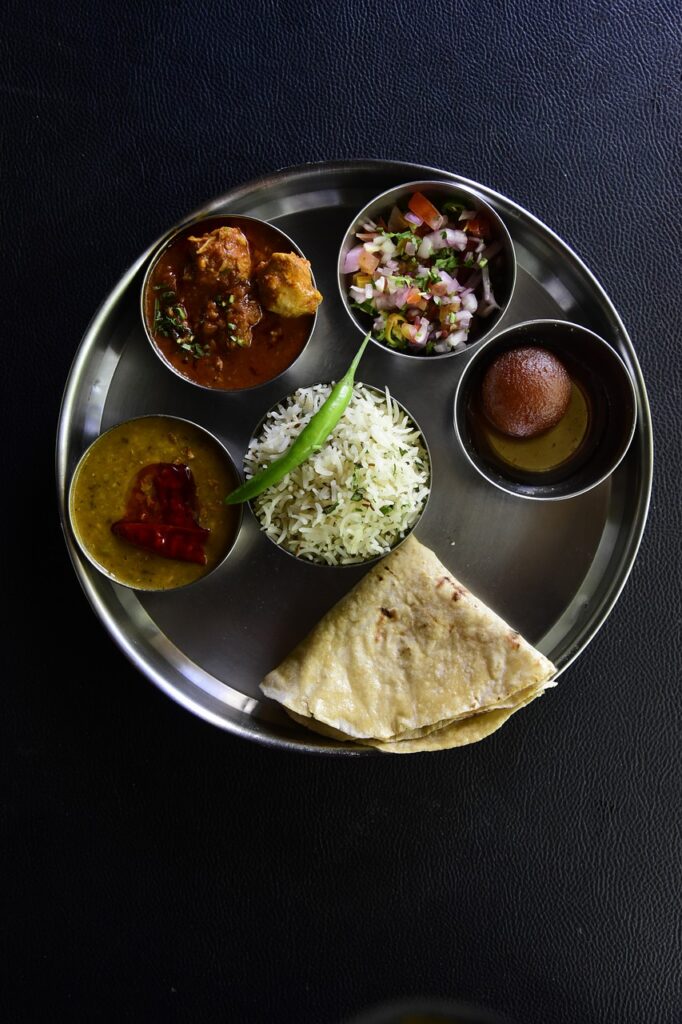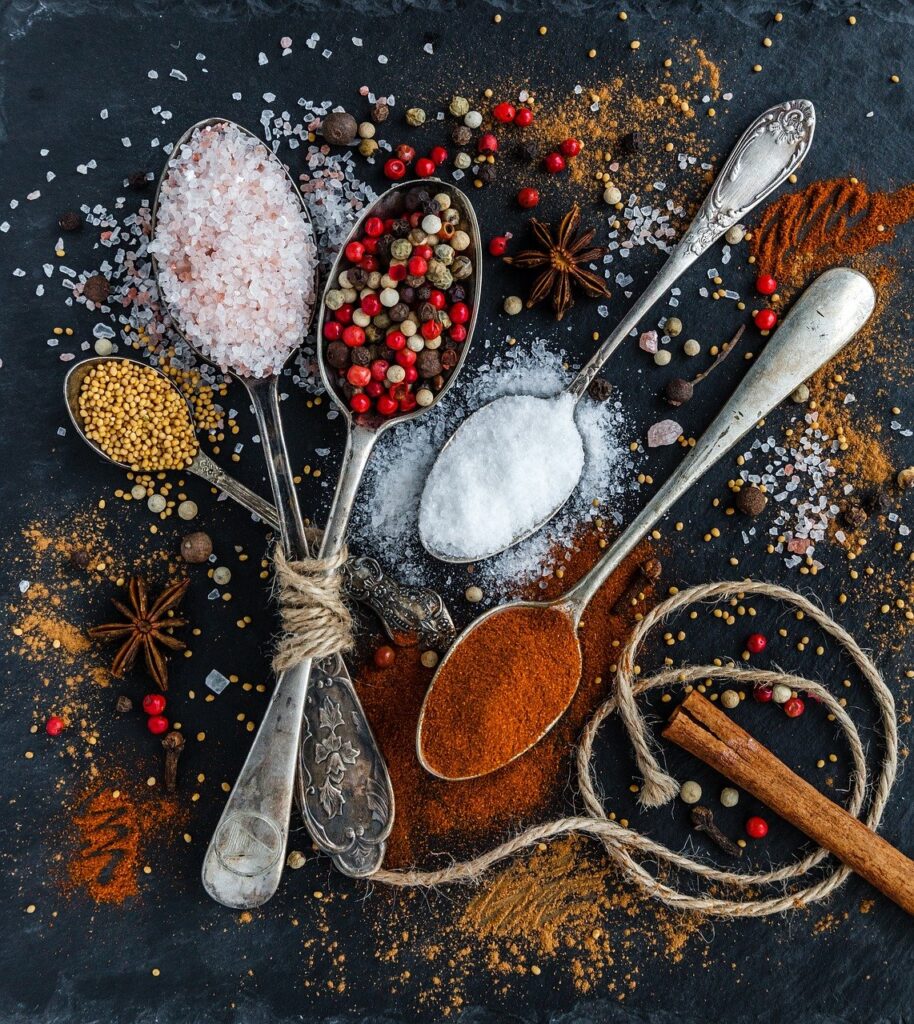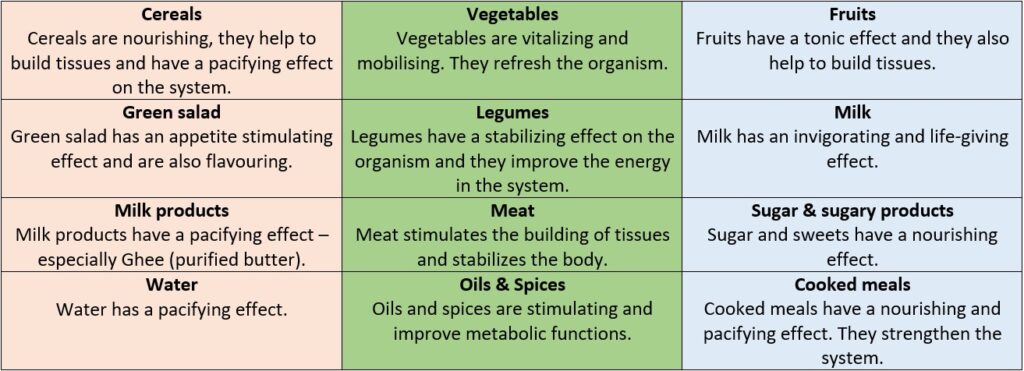Ayurvedic diet

Basis for an individual diet according to Ayurvedic principles is the knowledge about Tridosha and one´s personal doshic constitution. Roughly 70 to 80 % of all diseases can be avoided if a proper diet and an according lifestyle are maintained. Food is not only the fuel that our body runs on, as we often hear nowadays, it is the basic building block out of which our very bodies are produced and maintained. This means that our bodies are mainly an expression of our intake of food and beverages. In Sanskrit and Yoga the term „annamaya kosha“, the food body sheath, is used to describe the physical part of our being. So if we follow an Ayurvedic diet that maintains the balance of our doshas, we get a healthy and vital physical body, free from ailments and early degeneration.
According to this knowledge, we can preserve our health and wellbeing by following the Ayurvedic principles of diet and nourishment. However, if a person falls sick, there are also special therapeutic diets that can be administered by a physician or specially trained Ayurvedic food therapists. For this type of nutrition, a detailed diagnosis of the patient is required and the diet has to be followed strictly for a certain time period. It is usually complimentary with a personalized treatment protocol including panchakarma treatment and other special treatment options to target the individual problems of a patient.
Tridosha and diet
Ayurvedic diagnostics are based on the tridosha principle. The three doshas that govern physical life are:
- Pitta – the fire – governs the whole alimentary canal
- Kapha – the earth element – governs all mucosal actions and fluids present in our body
- Vata – the air and space element – governs the neurological and respiratory functions
These terms may not sound very scientific to the western ear and allopathic standards but the terminology is not to be taken literally. The three doshas minutely describe their influence on the human mechanism and each of these qualities has specific functions to maintain the physical and mental wellbeing of a human.

Pitta
As pitta is composed of fire and water it governs the digestion of food. All the metabolic processes are the result of pitta. The hormonal production, bile and enzymes present in our body are products of the pitta dosha. It breaks down the complex food substances and provides the nutritional energy to the body that forms, builds and renews all the physical structures.
Pitta is described as being hot, light, sharp, oily, acidic and moving. It is contained in bodily fluids, sweat, the lymphatic system, the blood and the intestines. These systems tend to generate heat in the body. Conversion and transformative processes are governed by pitta dosha.
It is present in sweat, fluids, lymph, blood and intestine. And they tend to generate heat.
Physiologically, all the conversion and transformation in our body and mind is the result of pitta. It enables us to see and is responsible for hunger, thirst and helps to keep the body tissues soft and the skin glowing. The digestive power of pitta is the main contributor to a youthful appearance. On the mental level pitta can result in jealousy, greed, will power, anger and high intellect.

Kapha
Kapha is responsible for retaining moisture and lubricating the joints in the body. It maintains physical strength and governs the structures of bones etc. Kapha is also promoting a smooth function of our different body parts and it also provides stability, fertility, energy, patience and generosity in a human being.
Kapha is predominant in the joints, tendons, ligaments, connective and fatty tissues, the lymph, lungs, chest, head, throat and mucus.
Physiologically it moistens the food we eat and converts it into a bolus. It lubricates the joints through the synovial fluid and provides strength to the tissues. Kapha is also responsible to store the energy in the body.
On the psychological plane, kapha can provide us with stability, fertility, energy, patience and generosity.

Vata
The charaka samhita describes vata as the power which helps in inspiration, expiration, walking, talking and everything including excretion, parturition in an appropriate manner. Vata governs all the functions of mind and body.
Vata depicts ether and air. Just like air is necessary for life on earth to function, everything is dependent on Vata in our body. Vata is known as the king of the doshas.
Vata is characteristically dry, rough, subtle, cold, light and enables mobility. Vata is mainly located in the urinary bladder, large intestine, lumbar region, thigh, foot and bones.
It governs all the physiological functions of the body like nerve impulse, circulation, menstruation, movement of muscle, tissues and so on. Psychologically it governs speech, flexibility and quickness of thought.

Doshas and their food qualities
In the table below you can find the recommended qualities and tastes to pacify the three doshas.

According to our doshic constitution, we can use and combine the pacifying and recommended food items in our daily diet. This list is meant as an aid to finding useful and supporting types of food that will enable you to adapt your meals to an Ayurvedic meal plan. If you receive a detailed diet plan for Doctor Prakash you will find certain types of food on that personalized list that should be avoided even though they are listed in the table above. If you want to follow a general Ayurvedic food plan it is a good starting point to include some of the foods on the table in your meals.
Flavours in Ayurvedic meals

A central aspect of preparing a meal according to Ayurvedic principles are the six flavors and their incorporation in the meals. Ideally, a meal contains the flavors that support the doshic constitution of the eater and harmonizes one´s doshas. Each flavor has a specific effect on the physical and mental wellbeing of a human. These are the six flavors and their impact on the doshas:
- Sweet (madhura) – is a well known flavour known from childhood and nourishes all the tissues (dhatus) in the body. It harmonizes Vata and Pitta.
- Sour (amla) – is recommended for starters as it enhances the metabolic functions prepares the body to digest the food properly. It strengthens the cardiovascular system and pacifies Vata.
- Salty (lavana) – reinforces the flavour of the food and enhances the digestive power. Salt should not be overused if Pitta and Kapha are predominant in the doshic constitution.
- Spicy (katu) – enhances the digestive power and reduces Kapha. Be careful with spicy items like chilies as they can also aggravate Pitta.
- Bitter (tikta) – helps the tongue and the taste sensation. It can interfere with the proper building of tissues and create other Vata disorders if overused.
- Adstringent (kashaya) – is naturally dry, cold and reduces inflamations. It is helpful in all Pitta disorders.
The 12 Ayurvedic food groups
Ayurveda differentiates between twelve food groups that have certain effects on the body and psyche of the human system. Each food item that we eat, has an effect and can help the body to build tissues and strengthen the whole system. Of course, we should not consume food excessively and handle all edible items carefully. In India food is considered as God in as far as it is life giving and sustaining. One should always refrain from eating processed items, chemically added flavors and artificial sweeteners as they have a negative impact on our health and wellbeing. Every food also has an impact on our mental wellbeing and can help us in pacifying our minds. Alcoholic beverages should only be consumed in small quantities on special occasions. Below you can find a list of the twelve Ayurvedic food groups and their effect on the human system.

Eight factors of healthy nutrition
Ayurvedic diet includes eight central factors to ensure a healthy and nutritious diet that does not build up deposits or excessive waste products (ama in Sanskrit) in the body and helps the metabolism to work at an optimal level. By incorporating the Ayurvedic factors concerning food and diet we strengthen the whole organism and our immune system to avoid disease and experience wellbeing and vitality.
The following factors have an impact on our meals:
- Prakriti – the properties of our food has an important influence on us. High quality ingredients, organically grown and without chemical components ensures good quality for our food.
- Karana – the way we prepare our food is the second important factor. The chef becomes a healer through the thorough and mindful preparation of a meal. Raw or cooked, sliced or mashed, all the steps of the food preparation have an influence on the effect of food.
- Samyoga – the combination of certain food types in a meal makes it digestible and nutritious.
- Rashi – the quantity of food is another decisive factor when we consume food. Intake of large quantities and constant snacking are the main contributors to ill health and many diseases.
- Desha – the origin of our food should ideally be regional and the food items need to be well balanced concerning the five basic elements. Regional, seasonal and organic is an optimal choice.
- Kala – the season and the time in the day when we consume food should also be considered to ensure a healthy way of living.
- Upeyoga Sanstha – choosing a comfortable and peaceful atmosphere and place to eat without stress or time pressure relaxes our nervous system and ensures that we can digest the food properly.
- Upyokta – healthy food should also be tasty and cause positive emotions in us. When we are happy and joyful while having a meal, the food can unfold its full healing power and nourish the body properly.

